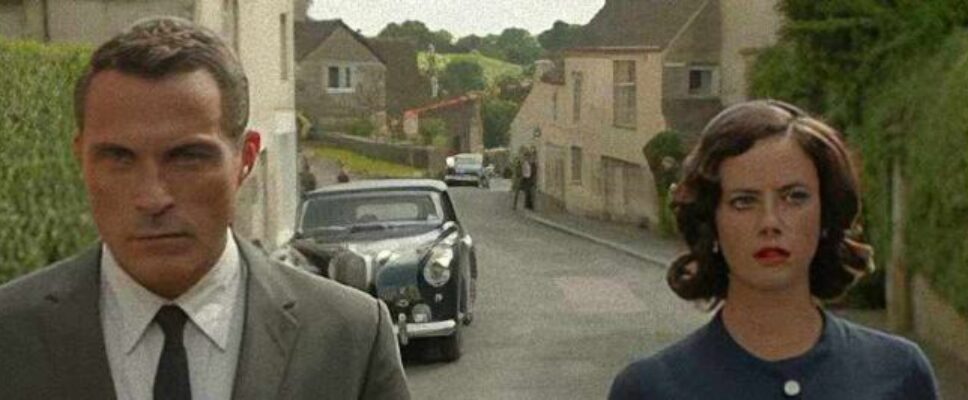Teresa Reviews “The Pale Horse” (2020)
Teresa reviews “The Pale Horse” (2020) and enjoyed Sarah Phelps’ changes to the Christie novel.
Fidelity to text: 2 ½ poison bottles
![]() This is true to the spirit but not to the text. What is real? What is smoke and mirrors? Who can you trust?
This is true to the spirit but not to the text. What is real? What is smoke and mirrors? Who can you trust?
Quality of movie on its own: 4 poison bottles
![]() Hypnotic and eerie, sunny horror juxtaposed with smart, upper-class Londoners who discover the world is stranger than imagined.
Hypnotic and eerie, sunny horror juxtaposed with smart, upper-class Londoners who discover the world is stranger than imagined.
Read more of Teresa’s Agatha Christie movie reviews at Peschel Press.
Also, follow Teresa’s discussion of these movies on her podcast.

This version has undergone the most radical transformation, even more than inserting Miss Marple as in the 2010 Julia McKenzie version. Mark Easterbrook, our lead, isn’t just peripherally involved. Nor does he get involved by being accused of murder as in the 1997 version. Instead, his name is on the list of mysteriously dead people. Except, of course, he isn’t dead yet. He has to figure out why someone wants him dead.
There are other changes in store for Mark. He’s a high-end antiques dealer. He’s got a perfect new second wife. He’s got a sad past with a perfect dead first wife he’s grieving over. He’s well-connected with upper-class friends facing a strange new world. He’s carrying on an affair with an upper-class but rebellious girl who’s a hostess in a seedy nightclub.
Yes, our hero is an adulterous cheat. Worse, he’s a lying dog. When he wakes up next to Thomasina Tuckerton’s body, does he inform the police? Call her family? Call a doctor? Of course not. She’s dead and he doesn’t care. Why should he? He has no obligations to anyone except himself.

She knows he’s cheating and she proves it to herself.
I felt very sorry for Hermia. She’s killing herself to be the perfect upper-crust housewife. She’s making puff pastry cases for vol-au-vents for God’s sake, then piping in salmon mousse filling. Why? To entertain friends who don’t appreciate the tedious hours it takes to master puff pastry. This being 1961, Hermia couldn’t buy ready-made puff pastry from the freezer case at the supermarket. She had to make it herself with her own dainty hands.

Mark gets summoned into Inspector Lejeune’s office about why his name might be on the list. He’s baffled. He also doesn’t admit he knows about Thomasina’s death, despite her name being on the list and this information being possibly helpful to the police investigation. At the station, he meets Zachariah Osborne, small-time hardware store owner. Osborne’s got bad teeth, an annoying manner, is clearly working-class, is even more clearly a loon.
Except strange things keep happening. Mark keeps having creepy dreams about the tragic death of his first wife, Delphine. Corn dollies (which have ritual significance in harvest magic) keep appearing on his car. Osborne’s claiming that witches are killing the people on the list, and Mark’s beginning to that this nutter shouldn’t be ignored.


As you’d expect, the three witches are enjoying the festivities. The witches aren’t stupid. They can read newspapers. They’ve noticed that a surprising number of their fortune-telling clients have had close relatives die after the consultation. They’ve also noticed that Jessie Davis, the woman with the list of names in her shoe, seems to be connected to the deaths. Although it wasn’t clear, I believe this is why when she asked to speak to her dead mother, Sybil passed on a hateful message telling Jessie how unhappy her mother was with what she was doing.
Or perhaps Sybil really did channel that message from Jessie’s mother.
This Pale Horse treated the occult with more care than usual. It opened with the usual pan across jars containing weird stuff, but afterwards, the usual smugness towards quaint rustic beliefs disappeared. It’s clear the villagers conducting the Lammas Day parade were serious about it. The witches knew when Mark was spying on them. They correctly foretold what would happen to Delphine’s marriage.
They have some power, but it’s not like the magic in Harry Potter. Dion Fortune defined magic as the art and science of causing change in consciousness in accordance with will. Whose consciousness? Whose will? In this case, they willed Mark’s thinking to change. He began to accept that things were not as rational as he’d always insisted. He certainly didn’t behave rationally. If he had, he would have listened to Delphine. He might have told the truth to the police. He might not have cheated on Hermia. He did what he damned well pleased, justified his actions as being logical and wise, and the devil take the hindmost.
My understanding of the supernatural is why the ending did not confuse me. Mark accepts that his godson David had his aunt Clemency (whom Mark loved!) murdered so he could inherit quicker. He asks the witches to remove the obstacles in his own path (Hermia and Inspector Lejeune) like David did. Later, he’s in the hospital because Hermia’s in a drug-induced coma. He witnesses Inspector Lejeune being rushed down the hallway on a gurney to the emergency ward. The inspector is bleeding from his eyes, nose, mouth, and ears.

So when you see at the end Mark Easterbrook revisiting his murder of Delphine, over and over, he’s getting the punishment he asked for. The witches would tell him that the world is stranger than we know and we defy God at our peril.


